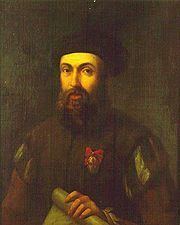Goa under Adil-shah
1. Political System
The three strongest of Bahamani nobles-Yusuf adil khan, Ahmed nizam khan, and Qutub khan agreed to divide Deccan among themselves. In this division, Bahadur glani's estates of Belgaum, Goa and neighbouring districts were assigned to Bijapur. Glani did not resist the transfer of his loyalty from Bahamani's to the Adil-shah, and in token of his approval went in with 6000 horses to Bijapur, the capital of his new master.
Around 1500AD. in a fresh treaty, the commander of Goa agreed to acknowledge Yusuf Adil shah of Bijapur as his sovereign(master). Considerably, impressed by its grandeur of Goa built on bank of river Mandovi and enriched by prosperous trade on land and Sea. Adil shah chose to stay in Goa whenever possible. The glory of Kadambas and their twin capitals-Chandrapur and Gopakapattan had set and as is the law of nature, trade shifted to new centre in Ela, Goa. The port that had been built by Adil shah sets up a very good example of good administration.
 |
| Adilshah |
Passport procedures like, recording arrivals and departures at every point, identification of travellers were introduced. Interestingly, the width of paved ways, the spacing between architecture were all indication of a planned development, comparable to modern times. It is probable that, with vast trade surpluses, Adil shah must have succeeded in having services of eminent architects and city planners, from within and outside sub-continent. Liberal patronage to art and architeture, literature and fair/just sytem of admnistering justice were hallmark of Adil shah's government in Goa. The system of revenue administration was already set-up in days of Bahamanis. Mahmud Gawan further re-organised it. It appears that, by for Adil shah's govt. was secular in character. There were appointement of prominent Hindus, Dessai, Sardessai, Deshpande, Deshprabhu and rusting large garrisons in such people's hands shows that, Adil shah laid stress on Loyalty, rather than religious label of a person.
'Duarte Barbosa' has given a description of Muslim city of Old-Goa as follows. The city was inhabited by Moors, respectable man and foreigners and rich merchants. There are also many great gentile merchants. There are also other gentleman cultivators and great men at arms. It was place of great trade and has good port to which flock many ships from, Mecca, Hormuz, Aden, Cambay, Malabar. The town was very large and there was good edifices and handsome streets surrounded by a wall and watch towers.
Also Read: Kadamba Brilliant Administration
Also Read: Visionary Rulers
Also Read: Outstanding rulers
Tomepires came to Goa in 1511, said that, "Goa was a better part than Chaul in Maharashtra and had lavish trde. The 'Goanese' had a roving aramada. Goa produced goods and sea-men who could stand hard work. There was plenty of goods available and good craftsmen , who constructed ships which were esteemed everywhere. Goa produced high variety of beettle nut, which was exported to Aden, Hormuz and Persia.
2. Trade and Commerce[100AD-1500AD.]
As suggested by early inscription, Goa was an important trade centre. Since early times, Goa was ruled by powerful and less powerful feudatories at different times. Therefore, there had developed a class of land owners, within the multiplicity of villages organized into Desha, Mahal, Tanadarias. There was a local oligarchy of Gaonkars and Dessais and Sardessais who retained enough surlplus in their hands to attract the traders. The earliest list of custom duties, dates from 11th cent. A copper plate of Jaykesi-1 lists various lands in sea contact with Gopakapattan. The port town, like Old Goa could have survived without continuos supply of victuals(essentials) from neighbouring and far away hinterlands.
A very traditional form of inland trade was common in the country. The Goan markets had their seasonal fairs that enabled villagers to dispose off their surplus produce, whether of agriculture or domestic crafts and produce in exchange other provisions that they needed. The merchants dealt with gold, silver, pepper, fruits, spices, camphor, cotton cloth, food items, perfumes, beettle leaves etc.
 |
| Adilshah palace Panaji |
3. Industries
Industries flourished during period were, spinning, weaving, brass and bronze works, carpentary, jewellery, iron goods, basket-making, oil-making, pottery etc. Under Kadambas, industries were regulated by guilds called 'Shrenis'. The trading settlements and settlements of artisans were known as 'Hanjuman nagar'. The "setthis" or "shrestis" were the heads of the shrenis of both, artisans and traders, and are often referred to in the Kadamba records. It is evident that, the guilds and shrenis also served as local bankers. The commercial prosperity of Goa during this period was supported by gold coins discovered at Chandor, Gopakapattan and many other places. These include, the gold coins of Jaykeshi-3, Sovideva etc. They are of pure gold. The smallest coin is called as 'Pana' and weighed about 6 grains. Panas were disscovered at Chandor. The gold coins named as 'pratapas' were used uder the Vijayanagras. The Persian silver coins called as 'Ashrafi' was also in use. Early Kadamaba inscription in Goa make certain references to Gadnyas, Nishkas, Drammas, and Tare.
At the time of Portuguese conquest of Goa in 1510, the currency denominations were known as 'pagodas'. The pratapas were equivalent to 'Hons'. Also currency was 'Lari' and Adil shah's silver coins of persian origin. The natives of Goa had smaller fractional denominations called 'Dombady' and 'Duddu' which was way of counting.
 |
| Tome-pires |
There were Sarafs in the market to determine exchange values. The 'Mahars' always lived on the frontier of the village. It appers that, not all artisans lived in the village and that, Sutar, Kambhar, Malli, Lohar, Chambar etc. could be serving more than one village. Some craftsmen were obviously found in those areas which provided material fit for these craft. The other known artisans were Shet, Kansar, Shimpi etc.
Thankyou!
Best Range Of Products For You!
0 comments:
Post a Comment